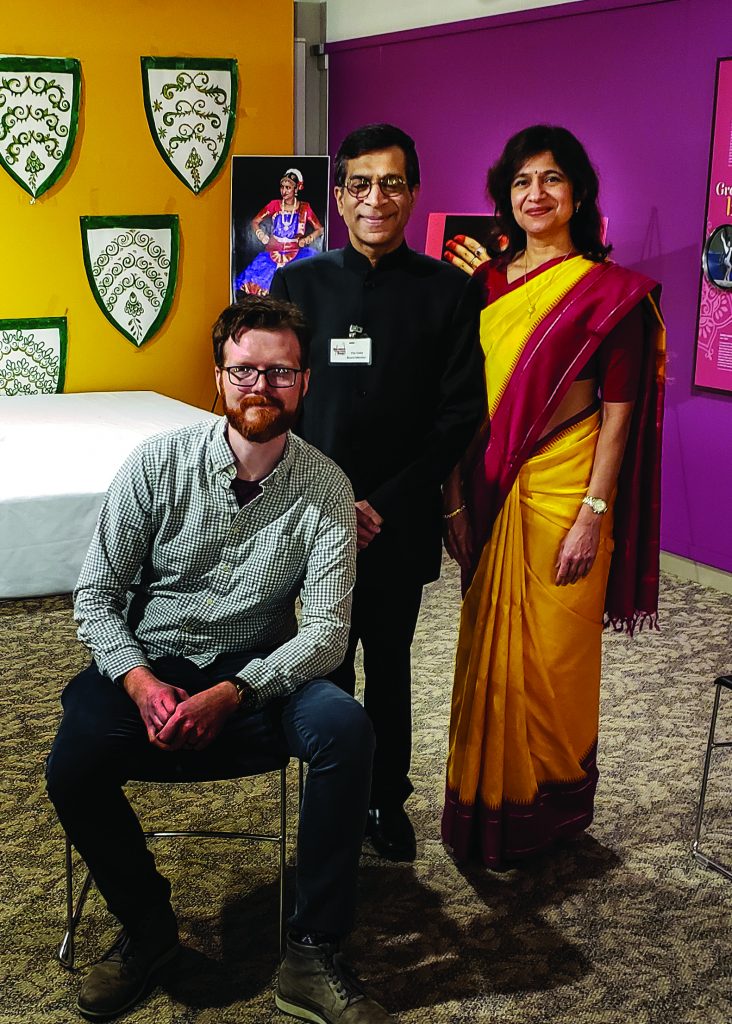
Drs. Vijay and Anu Gaba lead the committee of local Indian Americans who helped Markus Krueger (left), HCSCC program director, put together the first history of the highly educated newcomers to the Red River Valley. It’s featured as part of “Beyond Bollywood,” on exhibit at the Hjemkomst Center through March 31. (Photo/ Nancy Hanson)
Nancy Edmonds Hanson
hansonnanc@gmail.com
Immigrants from India have had an outsized impact on Fargo-Moorhead in the 50-some years since the very first family arrived. For the next six weeks, their neighbors can explore their stories and their contributions in “Beyond Bollywood,” a Smithsonian exhibition now showing at the Hjemkomst Center.
The national exhibition, which has spent several years touring the nation’s largest cities, focuses on the progress of Indian Americans, who first began arriving in the U.S. in the early 1900s. It brings together commentary on the impact these immigrants have had on American life, but also the culture they’ve brought along with them – the colorful traditions and Hindu religious beliefs that they maintain in their new home.
The Hjemkomst show, however, goes further by bringing that story close to home – a story being told for the first time. Programming director Markus Krueger worked with a committee of leaders of the local community to put together original research on Fargo-Moorhead’s Indian American population and culture – a short but remarkable history neglected or overlooked until now.
“Studying immigrant groups has always been important to us, with 86 percent of Clay County originally settled by Scandinavians and Germans,” Markus says. “But this is a thrill. Instead of looking at historical documents, here I am, meeting the pioneer families themselves – the first Indian American child born in North Dakota, many of the first families … who are still here. These are the people who historians will be reading about 100 years from now.”
Two Sanford Health physicians worked closely with Markus to dig up information on the impact those born on the subcontinent have had on Fargo-Moorhead and the region. It’s a group unlike any other to settle here, disproportionately well-educated and overrepresented in three areas – education, medicine and technology.
Drs. Vijay and Anu Gaba were drawn to the community in 2004. Dr. Vijay is an anesthesiologist. Dr. Anu, a specialist in hematology and medical oncology, is chief of the Roger Maris Cancer Center, chairs the medical oncology department and serves on Sanford’s physician executive committee. She’d completed a residency and fellowship in Baltimore and the Bronx before moving their family to Fargo. She says, “We planned to take it one year at a time. Despite the weather, we like it and we never found a reason to leave.”
Adds her husband, “Fargo-Moorhead has become our home.”
That’s why, when Markus introduced the idea of bringing the Smithsonian exhibit here, the couple was eager to help. Vijay had served on the board of the Historical and Cultural Society of Clay County for five years. He set out raising funds to bring “Beyond Bollywood” to the smallest city where it had ever been shown. Markus says the results were outstanding: “We’ve never had such enthusiastic support.”
With assistance from the Indo-American Association of the Great Plains, the Gabas opened doors to help Markus chronicle their story, from the arrival of the first Indian American in 1964 – North Dakota State University’s acclaimed wheat geneticist Dr. S.S. Maan – to the engineers and computer experts being drawn here today by Microsoft and other IT endeavors.
Science and, now, computer technology programs have made NDSU a magnet for students and scholars. Indian Americans have made perhaps an even more powerful difference in the field of medicine. Today 15 percent of North Dakota’s physicians are Indian American, along with a large share of their counterparts in Minnesota. Anu attributes that in part to the work of U.S. Sen. Kent Conrad of North Dakota, who led the campaign to ease J-1 visa restrictions by easing requirements for those who agree to work in areas where medical care is in short supply.
That local history has been added to the Smithsonian’s extensive exhibit, along with family treasures shared by members of the local Indian American community. But not content with posters, photos and artifacts, the locals guiding the exhibition have put together an ambitious program of almost-weekly events. Past sessions have included bhajans (devotional songs); Indian health day; Indian fashion shows for children and adults; a celebration of Indian Republic Day Jan. 26; Indian food art and decoration; historical glimpses of ancient, medieval and modern India; and a program on Hinduism.
A one-act play, “Living Beyond Bollywood,” is a highlight of the exhibition’s upcoming final month. Performed by local actors on March 9, it tells the story of Indian immigrants and their lives in short vignettes. Holi, the Indian Festival of Colors, will be celebrated on March 23. The exhibition’s final day is March 31.


